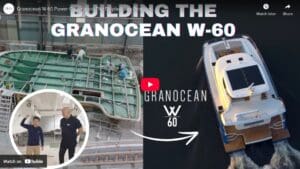 In the Overseas Radio Network Show 4, Segment 4, we will talk about a variety of topics for chartering a yacht and preparing for yacht ownership:
In the Overseas Radio Network Show 4, Segment 4, we will talk about a variety of topics for chartering a yacht and preparing for yacht ownership:
- Yacht sizes placed in charter
- Experience required for bareboat charter
- ASA sailing courses
- Preparing to charter a yacht
- Dinghies
GARY FRETZ: Welcome back to our show. I am Gary Fretz and we are talking to Stephen Cockcroft and Michel Benarrosh, two experts on cruising and using charter yachts to defray the cost of acquiring the said yacht. Guys, what are the smaller size boats and yachts that you can put into charter and what are the largest ones that can go into charter management?
For a transcript of this podcast, click “read more” below.
Yacht Sizes Placed in Charter
MICHEL: Well, the smallest one are…the smallest one I have seen…is the 31ft monohulls that are really for budget for charters. And that’s the smallest size on the charter fleet. The largest ones is bareboats. They are about probably in the 50ft range, the 50 to 52ft range.
GARY: Wait, explain what a bareboat is.
MICHEL: Oh, bareboat is a boat without a crew so it means that the boat is no bearing equipment in terms of crew and when you come with your party someone in the party is a skipper.
GARY: So that doesn’t mean you have to take off your clothes?
MICHEL: Whose clothes?
GARY: Okay, and you can go what, up to 50ft for a bareboat. And if you are talking about crewed yachts, they get that infinitely larger and including 300 feet large. Okay, guys, if someone wanted to try out this cruising life style, what sort of experience do you need to have, what do you need?
Experience Required for Bareboat Charter
STEPHEN: Well, if you want to charter a boat I guess you just need a gold Visa card to get one. No, I am just joking. You need to have relatively good experience on a similar boat to what you are chartering from a charter company. And the way to get that experience is probably if you are in a place that there are some sailboats is to try and get aboard them. If they race boats, get aboard one as swabbie as the crew and get out on the water. And there, of course, is the American Sailing Association which does a lot of sail training around the United States which prepares you for bareboat chartering and go out and find someone who is experience and get them to be your captain and go on charter.
But essentially the charter companies are looking for relative experience on the particular boat that you want to charter. Everyone has to start somewhere. No one starts knowing it all so never feel bad about the fact that you are going to learn. You know everyone is out there to help you.
ASA Sailing Courses
GARY: Why don’t you just tell us about the basic American Sailing Association courses that you can take?
STEPHEN: Okay, well there are the 3 initial courses:
- There is (ASA) 101 which is your very basic sailing
- You then get (ASA) 103 which is intermediate
- and then you get (ASA) 104 which is your bareboat chartering course. Essentially bareboat chartering course is a day captain’s course. It doesn’t really qualify you to sail at night. And there are not many charter companies that allow you to sail off to the sunset. Anyway most of them part of their rules are that you have to be an anchor on a mooring ball by the evening.
Catamarans Versus Monohulls
STEPHEN: Then the last course that you would probably want to do and be the (ASA) 114 which is a sailing catamaran course which is almost like a conversion course to catamarans. Catamarans are nice because they have a much shallower draft than monohulls so you can get in closer to shore and they are nice and stable. Shallower draft means you run aground in shallower water.
GARY: Now wait a second, you are the catamaran guru here, but we have we have another point of view in this room Michel likes monohulls better. Tells us about that.
MICHEL: Well, the monohull to me is the real sailing. The catamarans are very popular in the charter industry, but I think the feeling of, I don’t know, the feeling of the elements, the feeling of the wind, the feeling of controlling the boat and fighting the weather and when you go up wind. Those are sensations that typically you do not find on a catamaran.
The catamaran is obviously much more comfortable, much larger, and what have you. And I see Stephen disapproving strongly over there. But, you know, I like as I said in a previous segment, I like the feeling of the boat heeling and going into weather and that’s what I enjoy. I don’t, I like the catamaran when I have large party but I don’t have that feeling when I drive a catamaran.
GARY: Well, I would like to speak to this a little bit. There are a group of people who really get into a sort of the zen of sailing. They are like board sailors, kite boarders, who love the feel of the balance of sailing and you know they kind of get into the groove. It’s like entering this meditative state and I think on monohulls what Michel is trying to say is that you really get more of a sense of that and catamarans, they are not quite as sensitive.
Although Stephen is over there laughing at me. But when I had…I owned 2 cats and I noticed that you did feel the balance and the sensitivity when the wind blew up, you know, when it was blowing over about twenty something that thing got really sensitive, what are you laughing about.
STEPHEN: Well, with all the sailing and railing the water and all the wonderful stuff is really cool for about 45 minutes. And then after that the balance is the fact that you want your beer to be balanced and not go flying across the cockpit all the time the boat heels. I have done about 35,000 miles on a monohull and eventually you wish that one leg was shorter than the other one because you always got that wonderful feeling that your leg is in the water.
You know I think that people that climbing through the roof to get into the living room are eccentric person I like to walk through a pair of opening doors into the salon but of course I use to be a died-in-the monohuller until my wife told me I wasn’t anymore and now I absolutely agree with her.
Preparing to Charter a Yacht
GARY: Well you bring up some very good points and back to our subject of chartering to get experience in cruising. What would you guys take on a regular charter?
MICHEL: What would I pack? What I pack…it is easier to say what I don’t pack. Usually that’s the saying that we all have we are experienced charterers. We put all of our stuff that we want in a bag and then we put everything on the bed and then take half of it and put it back into the closet and it works very well.
As the years went by, I have taken less and less stuff on charter first of all because the boats are really well equipped and number two I realize that when I don’t even when I don’t take much half of it I don’t use so I go on charter for a week with not a handbag, but almost a small bag, you know like I don’t even check on the plane.
STEPHEN: Do you still take that lime green thong along that you always use to wear?
MICHEL: Oh, I would never travel without it, no question.
Dinghies
GARY: Those French European guys. Okay, guys let’s talk about dinghies. On a cruising boat a dinghy is used like a car. You run errands you go sightseeing drive it to where you want to go from where your home is, talk about some of the different types out there.
STEPHEN: Lot of different types of dinghy and I probably own just about everyone of them I have own a small hard branding gear I have owned small little inflatable dinghies with inflatable floors, inflatable dinghies with folding floors, hard floorboards. Without a doubt, the best dinghy is the inflatable RIB , just for all-around for stability. Put a big engine on it. You can get around fast. It is pretty dry. Eeasy to beach. And when you when you load your shopping it sits on a solid floor and doesn’t get wet so that’s the dinghy that I prefer.
MICHEL: One quick thing I want to add a lot of people use the dinghy obviously to go snorkelling and I have seen a lot of people who don’t think about the little detail when they get back to the dinghy at the end of the snorkelling they just kind of get back in the dinghy so for whatever reason they are not strong enough whatever the reason may be so think about taking with you as far as the stuff to pack with you. Take something that you can find in any marine store that will help you like a folding ladder or step that will help people getting back in the dinghy.
GARY: Well those sound like good tips. We were talking a little while ago about losing your yacht. And one time that happened to me. I was in Nantucket anchored in the fog and we went to dinner and the anchor dragged just in the sand. And came back boat wasn’t there. And we finally did find it just motoring downwind about a half a mile there was really no problem but it was a little disconcerting and what would you how do not lose your boat.
STEPHEN: Well there is some standard equipment you need to take when you go ashore even if it is midday because you might get hooked up testing a local beer out. I always switch on my anchor light on before I go ashore even if it is in the middle of the day I always take a little flashlight with me and I make sure that I know where my boat is.
GARY: Thanks, guys, we have to wrap-up. We will be back next week live on Thursdays 3PM eastern time US. And you have been listening to “Yachts: The Perfect Escape Vehicle” on the Overseas Radio Network. This has been Gary Fretz.






